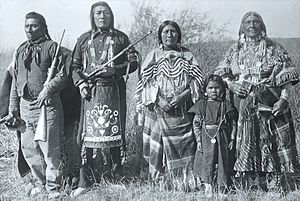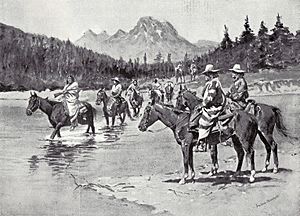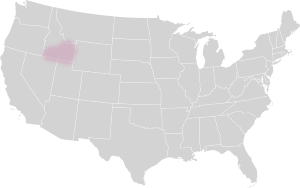Bannock people facts for kids
| panaki / kutsutɨkaˀa | |
|---|---|

Bannock people in Idaho
|
|
| Total population | |
| 89 alone and in combination | |
| Regions with significant populations | |
| Languages | |
| Northern Paiute, English | |
| Religion | |
| Native American Church, Sun Dance, traditional tribal religion, Christianity, Ghost Dance | |
| Related ethnic groups | |
| Northern Paiutes, Northern Shoshone, Mono |
The Bannock tribe (also known as panaki or kutsutɨkaˀa in their language) are a Native American group. They originally came from the Northern Paiute but share many traditions with the Northern Shoshone. The Bannock are part of the Indigenous Peoples of the Great Basin. Their historic lands covered parts of Nevada, Oregon, Idaho, and Wyoming. Today, many Bannock people are part of the Shoshone-Bannock Tribes of the Fort Hall Reservation of Idaho. This tribe is officially recognized by the United States government. They live on the Fort Hall Indian Reservation in Idaho.
Contents
The Bannock Tribe: A Look at Their History and Culture
Who Are the Bannock People?
The Bannock tribe is a unique Native American group. They have strong cultural ties to the Northern Shoshone. They are considered part of the Great Basin Indigenous Peoples. Their traditional homelands stretched across parts of what is now Nevada, Oregon, Idaho, and Wyoming. According to the 2010 United States census, 89 people identified as having Bannock ancestry. The Shoshone-Bannock Tribes of the Fort Hall Reservation currently have 5,315 enrolled members. These members are recognized as Shoshone-Bannock.
A Journey Through Bannock History

Life Before European Contact
The Bannock people have a rich history. Their ancestors, the Northern Paiute, traded with many nearby tribes. They lived off the land, using its resources wisely. Their ancient rock carvings, called petroglyphs, show their art from long ago. These carvings tell stories and share designs from their early culture.
The Horse and Buffalo Hunting
In the 1700s, tribes to the north began using horses. By the mid-1700s, some Northern Paiute groups also adopted horses. These groups became known as the Bannock tribe. Horses changed their way of life significantly. They could travel much farther and faster. Their lands stretched from Oregon to Nevada, Idaho, and Wyoming. They even traveled on the Bannock Trail to Montana and Canada. This was mainly to hunt large buffalo herds. Buffalo provided food, clothing, and materials for their homes.
The Bannock War and Fort Hall Reservation
The Bannock tribe played a role in American history. This was especially true during the Bannock War of 1878. After this conflict, the Bannock people moved. They joined the Northern Shoshone on the Fort Hall Indian Reservation. Over time, the two tribes became closely connected. Today, they are often known as the Shoshone-Bannock Tribes. The Fort Hall Indian Reservation is a large area. It covers about 544,000 acres (2,201 square kilometers) in southeastern Idaho. Other groups, like the Lemhi Shoshone, also live there.
Bannock Culture and Traditions
The Bannock people were very skilled. They made pottery and tools from bighorn sheep horns. They also crafted bags from salmon skin. Later, after glass beads were introduced, they used them to create beautiful designs. For traveling on water, they built rafts from tule reeds. Before the late 1800s, they fished for salmon in the Snake River. In the autumn, they hunted large buffalo herds. Buffalo hides were important for making tipis, their traditional homes.
Important Bannock Individuals
Many Bannock individuals have made important contributions. Here are a few notable people:
- Mary Jo Estep: An elementary music teacher. She survived the Battle of Kelley Creek.
- Sally Young Kanosh: She was the adopted daughter of Brigham Young. She married Chief Kanosh.
- Mark Trahant: A well-known journalist.
- Randy'L He-dow Teton: A model.
- LaNada War Jack: A leader in important student movements. She was also an activist, tribal politician, and academic.
See also
 In Spanish: Bannock para niños
In Spanish: Bannock para niños


